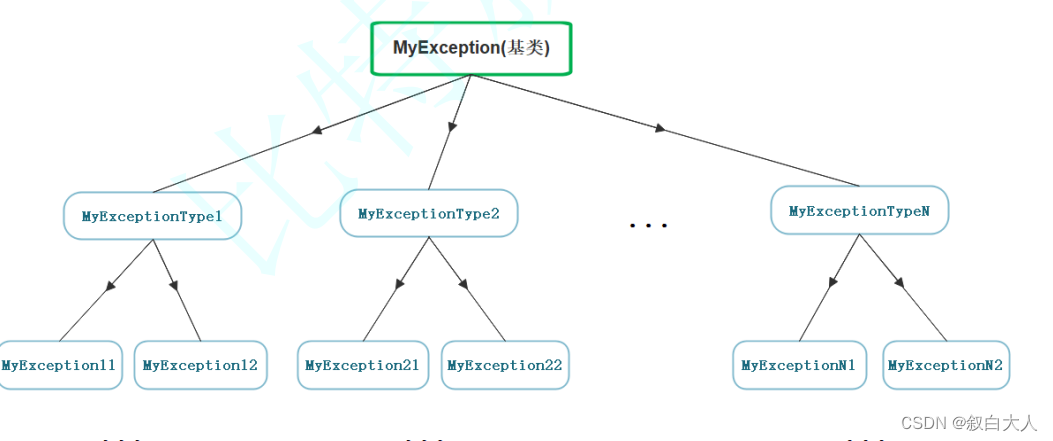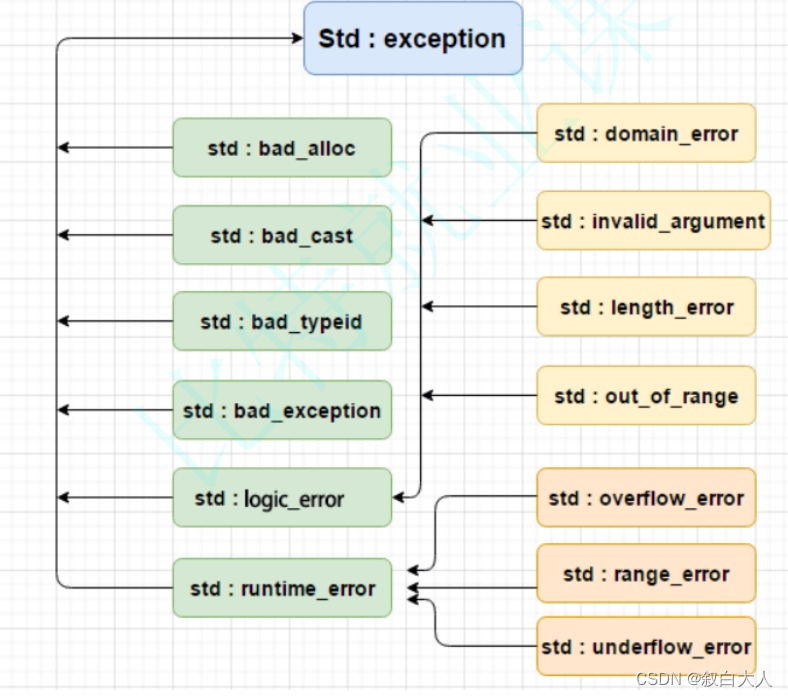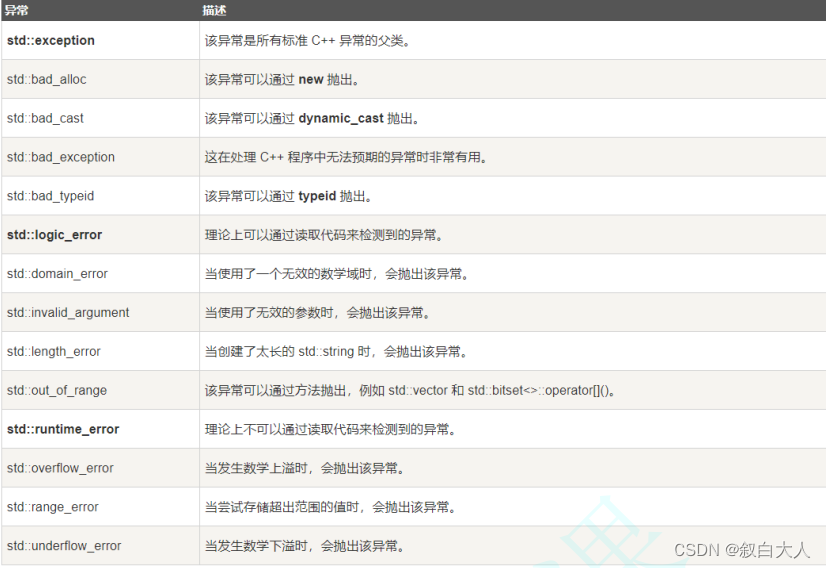一.异常概念
当一个函数发现自己处理错误时抛出的异常,让函数调用者间接处理错误。
1.throw:
当问题出现时,程序会抛出一个异常.这是通过使用 throw 关键字来完成的。
2.catch:
在您想要处理问题的地方,通过异常处理程序捕获异常.catch 关键字用于捕获异常,可以有多个catch进行捕获。
3.try:
try 块中的代码标识将被激活的特定异常,它后面通常跟着一个或多个 catch 块。
二.异常的使用
1 异常抛出和匹配原则
异常通过抛出对象引发,激活与处理对象匹配且最近的catch。
抛出异常对象后,生成拷贝对象传给catch(与函数传值类似)。也可以抛出派生类使用基类捕捉。如果到达main函数的栈,依旧没有匹配的,则终止程序。
2.异常的重新抛出
catch也可以再次抛出异常,当异常在当前catch中无法处理的时候,可以再次抛出catch给更外层的catch.
3.异常安全
构造和析构函数中最好不用catch,防止对象初始化不完整以及资源泄漏。
以及在lock和unlock中使用catch导致死锁。c++使用RAII来解决。
4.异常规范
函数后面接throw,列出该函数可能抛出的异常类型;
throw()表示不抛出异常;
若无异常接口声明表示可能抛出的所有异常类型;
// 这里表示这个函数会抛出A/B/C/D中的某种类型的异常
void fun() throw(A,B,C,D);
// 这里表示这个函数只会抛出bad_alloc的异常
void* operator new (std::size_t size) throw (std::bad_alloc);
// 这里表示这个函数不会抛出异常
void* operator delete (std::size_t size, void* ptr) throw();
// C++11 中新增的noexcept,表示不会抛异常
thread() noexcept;
thread (thread&& x) noexcept;
三.自定义异常体系
在项目中会对异常进行规范管理,所以实际中都会定义一套继承的规范体系。这样抛出的就是继承的派生类对象,捕获一个基类就可以了。

// 服务器开发中通常使用的异常继承体系
class Exception
{
public:
Exception(const string& errmsg, int id)
:_errmsg(errmsg)
,_id(id)
{}
virtual string what() const
{
return _errmsg;
}
protected:
string _errmsg;
int _id;
};
class SqlException : public Exception
{
public:
SqlException(const string& errmsg, int id, const string& sql)
:Exception(errmsg, id)
, _sql(sql)
{}
virtual string what() const
{
string str = "SqlException:";
str += _errmsg;
str += "->";
str += _sql;
return str;
}
private:
const string _sql;
};
class CacheException : public Exception
{
public:
CacheException(const string& errmsg, int id)
:Exception(errmsg, id)
{}
virtual string what() const
{
string str = "CacheException:";
str += _errmsg;
return str;
}
};
class HttpServerException : public Exception
{
public:
HttpServerException(const string& errmsg, int id, const string& type)
:Exception(errmsg, id)
, _type(type)
{}
virtual string what() const
{
string str = "HttpServerException:";
str += _type;
str += ":";
str += _errmsg;
return str;
}
private:
const string _type;
};
void SQLMgr()
{
srand(time(0));
if (rand() % 7 == 0)
{
throw SqlException("权限不足", 100, "select * from name = '张三'");
}
//throw "xxxxxx";
}
void CacheMgr()
{
srand(time(0));
if (rand() % 5 == 0)
{
throw CacheException("权限不足", 100);
}
else if (rand() % 6 == 0)
{
throw CacheException("数据不存在", 101);
}
SQLMgr();
}
void HttpServer()
{
// ...
srand(time(0));
if (rand() % 3 == 0)
{
throw HttpServerException("请求资源不存在", 100, "get");
}
else if (rand() % 4 == 0)
{
throw HttpServerException("权限不足", 101, "post");
}
CacheMgr();
}
int main()
{
while (1)
{
this_thread::sleep_for(chrono::seconds(1));
try{
HttpServer();
}
catch (const Exception& e) // 这里捕获父类对象就可以
{
// 多态
cout << e.what() << endl;
}
catch (...)
{
cout << "Unkown Exception" << endl;
}
}
return 0;
}
四.C++标准库的异常体系
C++ 提供了一系列标准的异常,定义在 中,我们可以在程序中使用这些标准的异常。它们是以父
子类层次结构组织起来的,如下所示:
























 869
869

 被折叠的 条评论
为什么被折叠?
被折叠的 条评论
为什么被折叠?








